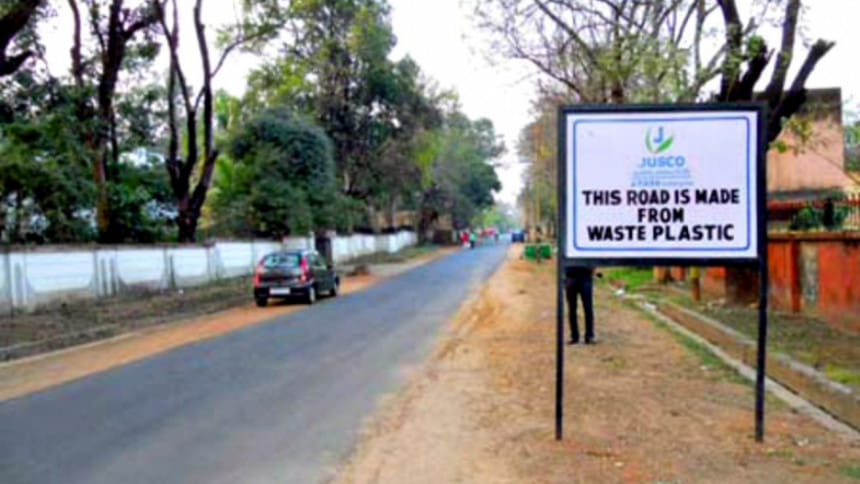Recycled plastic for roads

The idea of using discarded plastic to build roads was brought to fruition by a company called VolkerWessels in 2015. But the country where roads are now being built with this new technology is India. Indeed, the man who made it possible was Dr Rajagopalan Vasudevan, a professor of chemistry at the Thiagarajar College of Engineering in Madurai, who was honoured with one of India's highest civilian awards, the Padma Shri, in January 2018 for his ground-breaking research on re-using plastic waste in road construction.
Dr Vasudevan perfected the techniques to transform solid plastic into a molten condition which could effectively be mixed with bitumen, the black tarry substance that is combined with gravel to lay roads. The bitumen-plastic combination strengthens the road by making it both durable and flexible, and the plastic in the compound helps dispel rain water which in turn helps prevent structural defects such as potholes. The shredded plastic came from all the usual suspects: water bottles, single-use bags, chocolate wrappers with a thickness of less than 50 microns. According to Dr Vasudevan, "When using plastic as a binder, we're reducing the quantity of bitumen that is normally utilised for road laying by 6-8%." (The Guardian) Whereas a regular road needs 10 tonnes of bitumen for each kilometre, a plastic road would require only nine tonnes of bitumen and one tonne of plastic waste for coating, and this means solid waste management for plastics has found a new way to be useful.
Disposal of plastic waste is a global problem and innovative ways such as this are being implemented in several cities across India. For instance, the Jamshedpur Utility and Services Company (JUSCO) has been using plastic waste drawn from polybags to biscuit packets, which are combined with bitumen to make roads. The JUSCO has constructed 12 to 15 kilometres of road in the steel city utilising plastic waste. According to JUSCO, the savings in bitumen for every one km long and 4m wide road are Rs 50,000. It is not only the cost savings that are the selling point for this technology. Apparently, the quality and longevity of roads made with plastic waste is twice that of bitumen roads and those require no maintenance for the first five years.
The implications of this material are not lost on the Indian government. Back in 2015, the government made it mandatory to use plastic waste in construction of highways in India. The implementation of the regulation will of course take time as some states lag behind in segregating plastic waste. Nonetheless, the fact that 11 states across India have used the technology to build some 100,000 km of roads is a testament to its strength and durability. It certainly goes a long way in finding a commercial use for plastic waste.
In Bangladesh, we have seen what havoc plastic waste has caused over the years. With our inadequate and largely unplanned waste management practices, particularly in the urban areas, these wastes (which are non-biodegradable) are a major headache for the city planners. According to the Waste Concern, the rise in plastic consumption in urban areas increased substantially from 5.56 kg per person in 2005 to 14.9 kg per person in 2014. The result is an exponential growth in the volume of waste. Indeed, according to their data, plastic waste in Dhaka City increased from 1.74 percent in overall landfills in 1992 to 4.1 percent in 2005 and 6.5 percent in 2014. Plastic consumption is increasing every day but we are failing in waste management. There is a general absence of legal framework, institutional structure and industrial base for recycling to handle the waste that is being generated. Whatever waste recycling we see in our municipal areas is being done with a commercial outlook where a miniscule portion of plastic waste is being shredded for export. While the government has been trying out the 3R (reduce, reuse and recycle) initiative in Dhaka and Chittagong cities, it is merely the starting point of much bigger initiatives that the government must undertake.
Today, our roads are made primarily with bricks that are essentially made from clay. Hence during the rainy season and floods, roads become undone, requiring expensive repair which is invariably washed out during the next rainy season. While a debate rages on about substituting plastic, we should take lessons from neighbouring India which is transforming this environmentally-degrading product and putting it to good use. It would solve two problems with one stone: we could find a ready use for the increasing solid plastic waste that has no place to go, and reduce the maintenance cost of essential infrastructure, i.e. roads. Naturally, there will be a lot of resistance from brick kiln owners but what have we to lose (and everything to gain) from this exercise? Here's a clear prospect of having roads that are strong, durable and will at least free us from the growing mountains of plastic waste.
Syed Mansur Hashim is Assistant Editor, The Daily Star.





Comments